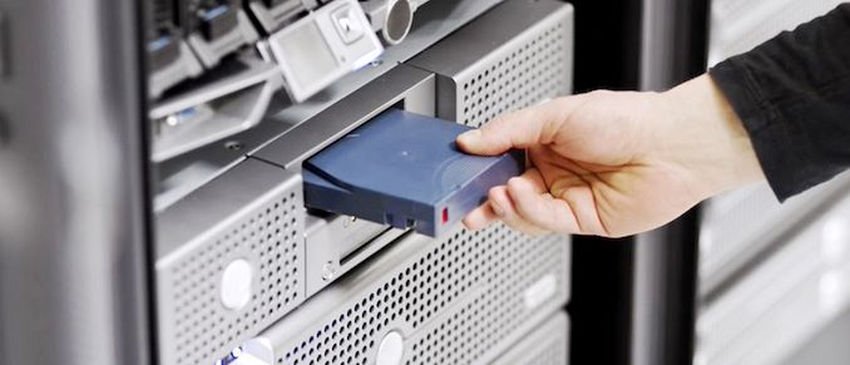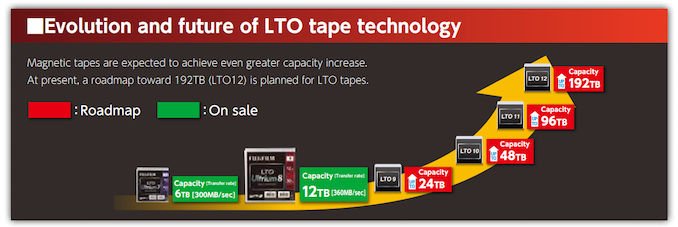One of the two leading tape storage manufacturers, FujiFilm, claims to have an advanced technology for magnetic Movies and that by 2030 it will allow a capacity of 400 TB per tape.

Such as reports Fujifilm the use of Strontium Ferrite granules will allow a data density of 224 Gbit per square inch in a tape, which would allow 400 TB disks.
IBM and Sony have already demonstrated 2017 Gbit per square inch technology in 201, with the technology likely to be released for commercial production in 2026. Current drives are around 8 Gbit per square inch, but the delay between research and mass production is quite significant.
Strontium Ferrite will replace the existing Barium Ferrite LTO tapes. Strontium is in the periodic table a row above Barium, which means it is a much smaller person. This allows the placement of much smaller particles and according to Fujifilm, Strontium Ferrite (iron strontium) allows for higher efficiency while at the same time increasing the particle density compared to Barium Ferrite (iron barium).

In the standard LTO nomenclature, we are currently in LTO-8 where the units have a capacity of 12 TB. The next generations in LTO tend to double the capacity, but here we are talking about the LTO-13 with 384 TB capacity. Commercially, there appears to be a 2,5-year average between two successive LTO standards and their commercialization. See the following table with the progress of the LTO standard:
| LTO creation progress | |||||||
| Template | Version | Trade | Length | Capacity | Speed MB / s | Time to fill | Material |
| LTO-1 | 2000 | 609m | 0,1 TB | 20 | 1h 23l | MP | |
| LTO-2 | 2003 | 609m | 0,2 TB | 40 | 1h 23l | MP | |
| LTO-3 | 2005 | 680m | 0,4 TB | 80 | 1h 23l | MP | |
| LTO-4 | 2007 | 820m | 0,8 TB | 120 | 1h 51l | MP | |
| LTO-5 | 2010 | 846m | 1,6 TB | 140 | 3h 10l | MP | |
| LTO-6 | 2012 | 846m | 2,5 TB | 160 | 4h 20l | MP / BaFe | |
| LTO-7 | 2010 | 2015 | 960m | 6,0 TB | 300 | 5h 33l | BaFe |
| LTO-8 | 2010 | 2017 | 960m | 12,0 TB | 360 | 9h 16l | BaFe |
| LTO-9 | 2014 | 2020 | 24,0 TB | 780* | 9ω 25λ * | BaFe | |
| LTO-10 | 2014 | 2022* | 48 TB | 1100* | 12ω 7λ * | Ba / SrFe | |
| LTO-11 | 2017 | 2025* | 96 TB | 1800* | 14ω 49λ * | srfe | |
| LTO-12 | 2017 | 2027* | 192 TB | 2400* | 22ω 13λ * | srfe | |
| LTO-13 * | 2021* | 2030* | 384 TB * | SrFe * | |||
| LTO-14 * | 2021* | 768 TB * | |||||
| * Unconfirmed / estimated | |||||||
The current generation LTO-8 cassettes take at least 9 hours and 16 minutes to charge and with the predicted speeds on future discs this will increase even more. Current LTO specifications are LTO-12, and the 400 TB will come with the LTO-13 standard.

Fujifilm states that 400 TB is the limit of Strontium Ferrite, indicating that new materials will be needed to go even further. To be able to compare, we are talking about storage with only 224 Gbit per square foot. Very small compared to mechanical hard drives that exceed 1000 Gbit per square inch today. There seems to be plenty of room here if technologies could converge.
Prices for current LTO-8 tape are the lowest of all other storage media. Depending on capacity, prices are around 0,8-1,0 cents per gigabytes. Currently, only Sony and Fujifilm are licensed to create LTO-8 media, however other companies such as HPE and IBM resell the same models under their own brand.





